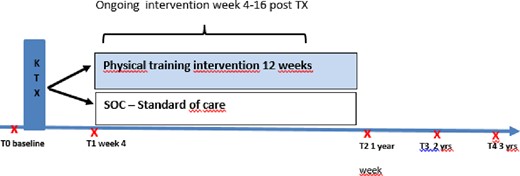-
PDF
- Split View
-
Views
-
Cite
Cite
Tommy Aronsen, Kristian Heldal, Kjersti Lønning, Emilie Hellwege, Marit Helen Andersen, #1391 Evaluating effect on frailty of a home-based training program developed for kidney transplant recipients (HOMETRAIN-KTR), Nephrology Dialysis Transplantation, Volume 39, Issue Supplement_1, May 2024, gfae069–1695–1391, https://doi.org/10.1093/ndt/gfae069.1695
Close - Share Icon Share
Abstract
Frailty and impaired physical function are prevalent among patients undergoing kidney transplantation (KTx), and is an independent risk factor for poor outcome after transplantation. Limited number of studies have prospectively investigated the efficacy of exercise training for KTx-recipients with low pre-transplant physical function. Our aim is to evaluate the effect of a structured 12 week home-based physical training program delivered to recipients with low pre transplant physical function, on physical function and frailty at 1-year post transplant.
HOMETRAIN-KTR is a 2-arm unblinded Norwegian clinical trial with RCT design (Fig. 1). Patients will be recruited at admission for KTx at Oslo University Hospital, Rikshospitalet. Patients who score below 60 at 36-Item Short Form Survey (SF-36) will be included and tested with 6-minute walking test (6MWT), Clinical Frailty Scale (CFS), hand-grip strength, 30 seconds Sit-to-Stand test, and questionnaire about physical activity and psychological distress. Included patients are randomized to either training group or control group (standard of care). The training group will, under supervision by a physiotherapist, start a 12-week structured home-based training program from week 4 post-KTx. The training program consist of a combination of strength training, cardio training and optional activities. During the intervention period, the intervention group will are receive regular follow-up by phone. The training sessions will be documented via patients logs and heart rate monitor (Fitbit). At one year post-KTx, all patients will undergo the same tests as at inclusion.
Inclusion of patients will start in January 2024, and continue for the next 2-3 years. We aim to include 200 patients, 100 in each arm. The study will evaluate physical function, frailty, graft function, patient survival, HRQoL and physiological distress during the time-span of the study.
The HOMETRAIN-KTR study is supposed to bring new knowledge about the effect of a physical training program on frail KTx-recipients. Such information is highly relevant to improve KTx outcomes and to optimize the utilization of the limited source of donor organs.

- physical activity
- renal transplantation
- heart rate
- exercise
- frailty
- follow-up
- frail elderly
- hospitals, university
- telephone
- tissue transplants
- arm
- transplantation
- health-related quality of life
- walking exercise test
- standard of care
- sf-36
- sit-to-stand test
- psychological distress
- physical function
- professional supervision
- 6-minute walk test
- norwegian
- donors
- fitness trackers
- strength training





Comments